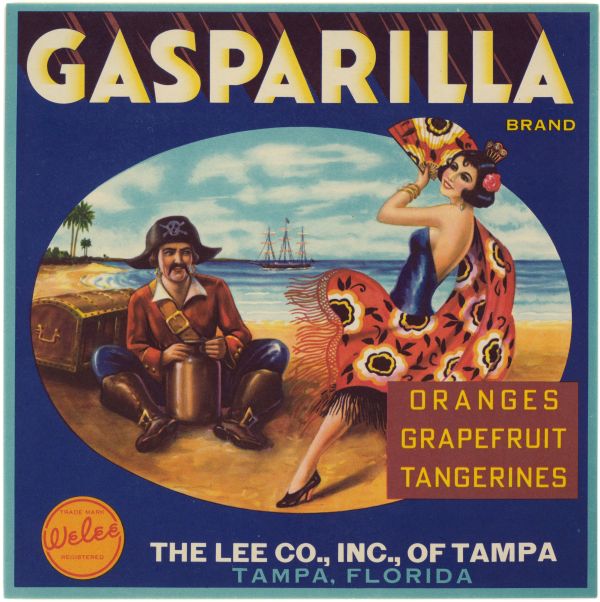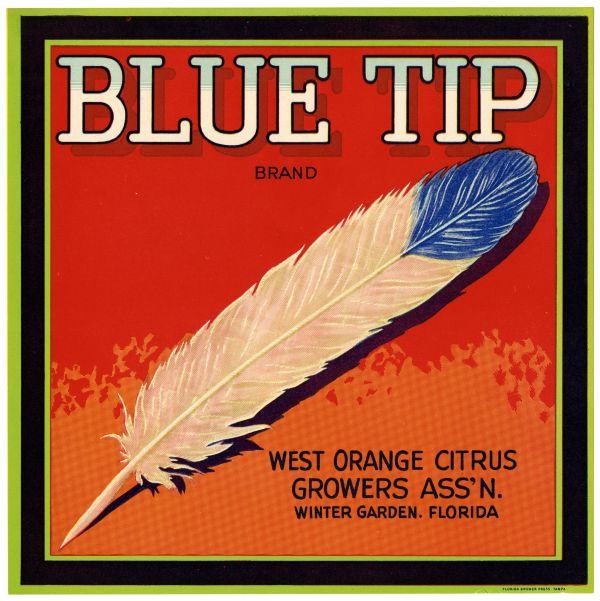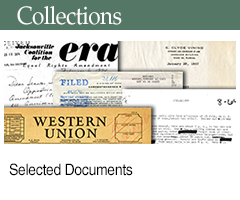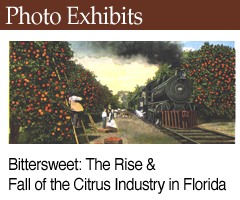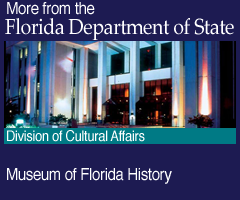Florida Crate Labels, 1920s-1950s
About These Documents
This collection consists of more than 600 crate labels from the Florida Special Collection at the State Library of Florida. Citrus fruits are native to Asia and were brought to Florida by Spanish explorers in the 1500s, with many of the earliest groves concentrated near St. Augustine. Florida’s citrus industry grew rapidly in the late 19th century, but the Great Freeze of 1894 and 1895 devastated growers as far south as Tampa and the Manatee River Valley. Many citrus growers moved their groves farther south, and some abandoned Florida altogether. By the 1910s, the industry had regained its footing and production was back up to where it had been before the Great Freeze.
With this new surge in citrus production, packers and shippers began designing labels to promote their produce locally and nationally. Labels were one of the first things a potential buyer would see, so it was important that they convey information quickly. Crate labels were a point of pride for packers and shippers, and often included a personal touch. Some even featured images of family members and pets. Creative names and colorful designs helped attract the attention of buyers, who would then sell the Florida produce at grocery stores nationwide.
Most of the labels in this collection advertise citrus fruits, but corn, celery, cucumbers, cabbage, avocados and other fruits and vegetables are also represented. The labels range in size from the standard 9-inch square label that was placed at the indented end of a wooden shipping crate, to the 6-inch square and 3-by-9-inch labels that were used for half boxes and gift boxes.
The majority of the labels were donated by the family of Harold and Geraldine Haskins, who for many years operated a successful antique shop in Micanopy before relocating to Tallahassee. Calling himself the "Florida Label Man," Harold Haskins specialized in fruit and vegetable labels and was widely known among collectors.
Background
The increasing availability of railroad and steamship transportation at the end of the 19th century made it easier to market Florida’s fruits and vegetables throughout the eastern United States. The faster produce could reach its destination, the fresher it would be. As more packing and shipping plants sprung up in Florida, companies had to find ways to make their produce stand out. To help give Florida fruits and vegetables an edge, growers looked to the booming produce packing industry in California, where advertisers were already using bold, elaborate labels to catch buyers’ attention. Florida companies began designing their wooden shipping crates and paper labels based on this successful model.
Paper crate labels were used in Florida from the late 1800s until the 1950s. The earliest paper labels were fairly generic and often didn’t include a brand name. Starting in the 1920s, advertisers began developing more complex marketing strategies, aiming to entice buyers with colorful brand names and imagery. The generic labels didn’t completely disappear, however. Packers still used non-branded labels for lower grades of fruit or when the supply of branded labels ran out. Also, smaller packing companies sometimes opted to have their name and information stamped onto stock labels they could buy more cheaply. The Alturas Packing Company, L.C. Bilbrey Fruit Company and W.E. Burquest, for example, all used the same octagonal label from the Florida Growers Press in Tampa for their products.
When World War II began, the need for colorful crate labels was diminished because much of the citrus crop went directly to the military. By the end of the war, improvements in packing and printing technology had made the labels all but obsolete. By the mid-1950s, cardboard boxes had replaced wooden crates for shipping produce, and company logos could be applied directly to the surface, thus eliminating the need for printed labels.
Bibliography
Chicone, Jr., Jerry, and Brenda Eubanks Burnette. Florida Citrus Crate Labels: An Illustrated History. West Palm Beach: Burnette and Associates, 1996.
Davidson, Joe. Fruit Crate Art. Secaucus, N.J.: Wellfleet Press, 1990.
Davies, Frederick S., and Larry K. Jackson. Citrus Growing in Florida. Gainesville: University Press of Florida, 2009.
McLelland, Gordon T., and Jay T. Last. Fruit Box Labels: An Illustrated Price Guide to Citrus Labels. Santa Ana, Ca.: Hillcrest Press, 1995.
Prange, N.M.G. Citrus Culture for Profit. Jacksonville: Wilson and Toomer Fertilizer Company, 1913.
Russell, Marilyn C. Classic Crates from Florida. Winter Haven: Florida Citrus Showcase, 1985.
Spencer, Donald D. Citrus Crate Labels of Florida. Ormond Beach, Fla.: Camelot Publishing Company, 2001.
Wheeler, H.J. Citrus Culture in Florida. Jacksonville: American Agricultural Chemical Company, 1923. http://catalog.hathitrust.org/api/volumes/oclc/1311402.html.

 Listen: The Bluegrass & Old-Time Program
Listen: The Bluegrass & Old-Time Program